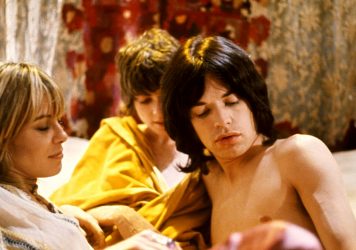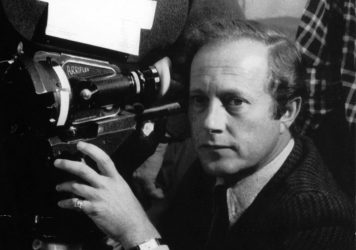This ghostly 1973 adaptation of Daphne du Maurier’s short story is a masterclass of staging, acting and editing.
The first six minutes of Nicolas Roeg’s baroque chiller Don’t Look Now are so utterly perfect, it’s easy to forgive some of the narrative flatulence of its latter half. It opens on a scene of two children, brother and sister, playing on the banks of a murky pond in the English countryside. The girl, Christine (Sharon Williams), is dressed in a famous red raincoat. Her white-blonde locks tumble down her upper back. She has tiny, beady eyes.
In the opening shot she is pushing a wheelbarrow while a heavenly white horse gallops and whinnies in the middle distance. Already you can see the possible crossover of worlds, where the horse has arrived from another plain to escort Christine across the border. Johnny, Christine’s brother, tools around on a bike, skidding around trees very much in his own world. The sun is low in the sky, coolly back-lighting the lush verge in which the pair frolic. The red of the raincoat is a searing blot on the frame, like a molten core about to explode.
The camera then switches perspective and we can see a big house in the middle distance. Christine is kneels over the pond from a small, mossy bridge, peering downwards and strategising how to retrieve the ball she just purposely tossed in there. We cut suddenly from the red coat reflected in the pond to a fire burning in front of a guard mesh – a pull-back reveals Laura (Julie Christie) and John Baxter (Donald Sutherland) going about their business, her reading a book, him flipping through slides of church interiors (he works as a church restorer).
In one of his slides John spots the same red coat, and director Nicolas Roeg holds on the reaction in his eyes for a moment, as attempts to decipher exactly what he’s seeing. He glances over to Laura, but her back is to the screen. He wonders if she’s spotted it too, and whether he should maybe show her, or ask her opinion. Another harbinger: Laura, it transpires, is searching for the answer to a question asked of her by Christine: if the world is round, why is the ice on a frozen pond flat?
John looks harder at the slide, directly rather than projected on the big screen. The figure in the red coat is clearly there. On the soundtrack, a spooky little arpeggio plays out on an electric synthesiser as Roeg and co-editor Graeme Clifford cut back to Christine by the pond. The tension mounts. Christine runs along the bank of the pond and the camera pans along, capturing her shimmering reflection. It’s a longish shot, with ghostly resonances.
Johnny, meanwhile, rides over and smashes a small pane of glass. The sound of the smashing is cross-cut with Christine’s foot penetrating the shallows of the water. It’s as if a translucent safety barrier on the pond has been broken. At that very moment, John looks up from his slide, reacting to the smash, but is instantly interrupted by Laura answering her daughter’s ice trivia. Laura puts her hand to her mouth and it cuts to Christine, bringing her hand down from the same position. The idea of psychic and physical connectivity is a theme that runs through the film.
Christine has managed to retrieve the ball, but decides to toss it back into the pond. The moment the ball hits the water, John spills a glass of water on the slide, and the red of the coat in the image begins to smudge and run. The ink resembles blood, if indeed it is not actual blood. Either way, it’s not looking good for little Christine. Her fate is sealed by this point.
Without a sound, John looks up and into the middle distance, like he’s attempting to intuit something but the information is too opaque to swiftly decipher. He edges towards the door before picking up pace and heading outside. He suddenly has to check on the kids. As he steps across the breach, Christine is seen (but not heard) descending into the pond, face upwards as if a struggle has already occurred and she’s at the point of giving up.
Johnny screams for help, but John runs straight past him, his eyes locked on the pond, now eerily still. He staggers and, in a single motion, wades into the gloomy water. Sutherland’s forceful conviction in this moment is heartbreaking in and of itself. He sees something, but we cut back to Laura who is now inspecting the smudged slide.
The red liquid bubbles, but she tosses it aside. It’s sits on top of a well-placed book named ‘Beyond the Fragile Geometry of Space’, which could be an alternative title for the movie. The liquid starts to shift across the frame. It’s sentient, draining from that little mysterious figure in the red coat and spiralling symbolically into the interior of the church. John has retrieved the now-limp Christine and, in slow motion, lifts her from the water, but it’s too late. He cradles her and screams out.
The soundtrack, at that crucial moment, includes the trill of a harp, directly followed by industrial bleating. And then we exit this momentary dream state, and John transports Christine’s corpse to the house after failing to resuscitate her. Laura, oblivious the the entire accident, sees John with the body and screams out, only for her agonised yelp to be interrupted by a hard cut of a drill burrowing into a stone wall covered in seaweed. It’s one of the great openings. Every frame is calculated perfection.
Published 4 Jul 2019
Nic Roeg’s horror classic on the trauma of losing a child is rolled out once more.
Some of its more fanciful machinations look a little quaint to the modern eye.
But the opening scene is an all-timer.

Jeremy Thomas invites us to rummage around his trinket-littered office.

By Jay Glennie
Read an exclusive extract from a new book celebrating 50 years of this groundbreaking British film.

In memory of this British titan of cinema, who died at the age of 90, we resurface a fascinating archive interview.